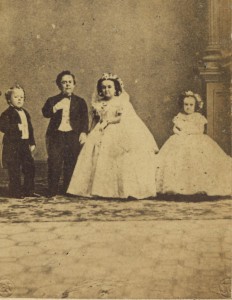Boston hosted most of the celebrated performers of the day, and Mrs. Gray saw many of them – and recorded her views, whether laudatory or critical. Within days of commencing her diary, in January 1860, she went to hear Frances Anne Kemble[1] declaim Much Ado About Nothing[2] and “felt the better for laughing heartily over her admirable rendering.”[3]
Saturday, 14 January 1860: Went on Tuesday to the Opera: Saffo.[4] [Marietta] Gazzaniga[5] was magnifique in it – [she] does act splendidly, and her deep tones expressing deep emotion are unsurpassed – some exquise music in it, too.
On Wed[nesday] went again [to] the Magic Flute[6] – delicious music and well cast.... [Gaetano] Ferri[7] was an admirable Papageno – and the Blackamoor, [Alessandro] Amodio,[8] incomparably comic. Gazzaniga, [Pauline] Colson,[9] and [Amalia] Strackosh[10] with [Giorgio] Stigelli[11] for tenor – his voice does not compare with [Pasquale] Brignoli[12] (whom we had [the] night before for Phaon [in Saffo]), but he is more painstaking....
Friday evg. opera again: Don Giovanni[13] with lovely little Adelina Patti[14] for “Zerlina” and Amodio for Masetto – the best Masetto we have ever had – his by-play was so admirable. [Augustino] Susini[15] made a poor Leperello and Stracosh a mere stick, as the wretched Elvira – though she sang well. Gazzaniga is always good.
Tuesday, 17 January 1860: A busy day, with dancing school p.m. from which I hurried home for the astronomical lecture, and was met at the door by an invitation to take Rebecca [Wainwright]’s[16] place at the Opera – she being too tired. Of course I was delighted to go since she could not, though very sorry for her disappointment. Little Patti as “Rosina” in the Barber of Seville[17] – a delightful evening...
Gazzaniga was in Boston later in the year:
Tuesday, 29 May 1860: At home all day, not feeling well, to save myself for the opera tonight. Gazzaniga’s farewell appearance – she sails soon for Europe. Certainly Saffo is one of her finest parts. She sings and acts in it splendidly.
Adelaide Philips[18] sang the “Climene”[19] finely but could not act it – her commonplace expression and snubby features, which do very well for saucy page or soubrette, have no possibility of approaching the pensive or tragic!
While the Grays consumed the high culture on offer, it should not be assumed that they (or, rather, their children) did not also sample the popular culture around them:
 The wedding of Tom Thumb (1838-1883) and Lavinia Warren (1841-1919),1863. Unsigned; mount stamped E.A. and M.B.
The wedding of Tom Thumb (1838-1883) and Lavinia Warren (1841-1919),1863. Unsigned; mount stamped E.A. and M.B.
Wednesday, 6 June 1860: ...Sam [Gray][20] went this evening with a party of boys to see Tom Thumb,[21] who is raising a fund for Barnum![22]
And again on Saturday, 9 June: ...The children went in the evg. to see Tom Thumb and came home much pleased & amused.
Notes
[1] The actress and author Frances Anne Kemble (1809–1893) married Pierce Mease Butler in 1834; they soon separated, and she was known professionally as Mrs. Kemble.
[2] Much Ado About Nothing (1598–99?) by William Shakespeare (1564–1616).
[3] 5 January 1860. All diary entries from the Hedwiga Regina Shober Gray diary, R. Stanton Avery Special Collections.
[4] Saffo (1840) by Giovanni Pacini (1796–1867).
[5] Marietta Gazzaniga (1824–1884).
[6] Die Zauberflöte (1791) by Wolfgang Amadeus Mozart (1756–1791).
[7] Gaetano Ferri (1818–1881).
[8] Alessandro Amodio (1831–1861).
[9] Pauline Marchand (1819–1877) was married to the tenor Charles Alexandre Colson.
[10] Amalia Patti (1831–1915) was married to the impresario Maurice Strakosch.
[11] Giorgio Stigelli (1819–1868).
[12] Pasquale Brignoli (1824–1884).
[13] Mozart's Il dissolute punito, ossia Don Giovanni (1787).
[14] Mme. Strakosch's sister Adelina Patti (1843–1919), the acclaimed coloratura soprano.
[15] Augustino Susini (1825–1883).
[16] The diarist’s best friend, Rebecca Parker Wainwright (1820–1901).
[17] Il barbiere di Siviglia, ossia l’inutile precauzione (1816) by Gioachino Rossini (1792–1868).
[18] The contralto Adelaide Phillipps (1833-1882).
[19] Perhaps La cour de Célimène (1855) by Ambroise Thomas (1811–1896).
[20] The diarist’s son, Samuel Shober Gray (1849-1926).
[21] The diminutive General Tom Thumb [Charles Sherwood Stratton] (1838–1883), long associated with the Barnum & Bailey Circus.
[22] The showman Phineas Taylor Barnum (1810–1891), often in financial difficulties.
Share this:
About Scott C. Steward
Scott C. Steward has been NEHGS’ Editor-in-Chief since 2013. He is the author, co-author, or editor of genealogies of the Ayer, Le Roy, Lowell, Saltonstall, Thorndike, and Winthrop families. His articles have appeared in The New England Historical and Genealogical Register, NEXUS, New England Ancestors, American Ancestors, and The Pennsylvania Genealogical Magazine, and he has written book reviews for the Register, The New York Genealogical and Biographical Record, and the National Genealogical Society Quarterly.View all posts by Scott C. Steward →